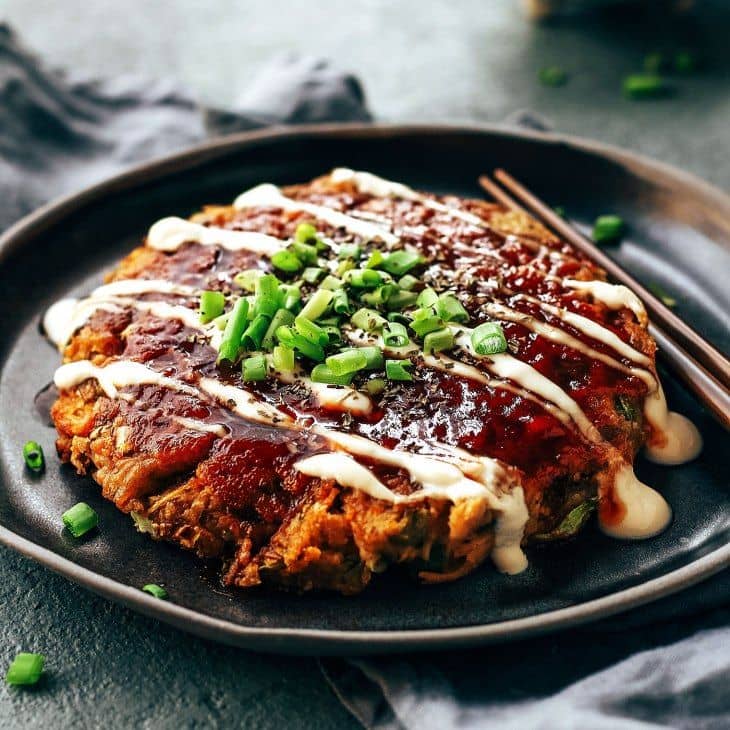Topped with a vegetarian okonomiyaki sauce, vegan mayonnaise, and traditional Japanese seasonings like Aonori (dried seaweed flakes) and katsuobushi (dried bonito flakes substitute or omitted for a fully vegetarian version), this dish promises a burst of flavors and textures. The flexibility of the recipe allows for personalization with additional ingredients such as corn, mushrooms, or tofu, making it a versatile and delicious choice for those seeking a plant-based version of this beloved Japanese comfort food.
Here’s a simple recipe for vegetarian Okonomiyaki, a Japanese savory pancake:
Ingredients for Vegetarian Okonomiyaki recipe:
For the batter:
- 2 cups shredded cabbage
- 1 cup grated carrot
- 1 cup chopped scallions (green onions)
- 1 cup all-purpose flour
- 1 teaspoon baking powder
- 1 cup water
- 1 tablespoon soy sauce
- 1 tablespoon sesame oil
For the toppings:
- Vegetarian okonomiyaki sauce (store-bought or homemade, made with soy sauce, ketchup, Worcestershire sauce, and sugar)
- Vegan mayonnaise
- Aonori (dried seaweed flakes)
- Katsuobushi (dried bonito flakes) substitute or omit for a fully vegetarian version
Instructions:
- In a large mixing bowl, combine shredded cabbage, grated carrot, chopped scallions, all-purpose flour, and baking powder.
- In a separate bowl, mix water, soy sauce, and sesame oil.
- Pour the wet ingredients into the dry ingredients and stir until well combined. The consistency should be similar to pancake batter.
- Heat a non-stick pan or griddle over medium heat. Lightly oil the surface.
- Pour a portion of the batter onto the pan, spreading it out into a round shape. Cook for 3-4 minutes on each side or until golden brown and cooked through.
- Once both sides are cooked, transfer the okonomiyaki to a plate.
- Spread vegetarian okonomiyaki sauce on top of the pancake.
- Drizzle vegan mayonnaise in a zigzag pattern.
- Sprinkle Aonori (dried seaweed flakes) on top.
- Optionally, add katsuobushi (dried bonito flakes) substitute or omit for a fully vegetarian version.
- Serve immediately and enjoy your delicious vegetarian Okonomiyaki!
Feel free to customize the toppings according to your preferences. You can also add ingredients like corn, mushrooms, or tofu to the batter for extra flavor and texture.
FAQs
-
What is a substitute for cabbage in okonomiyaki?
- While cabbage is a key ingredient in traditional okonomiyaki, you can substitute it with other vegetables such as shredded kale, spinach, or even grated zucchini. This allows for a variation in flavor and texture while maintaining the essence of the dish.
-
What is okonomiyaki batter made of?
- Okonomiyaki batter typically consists of a mixture of all-purpose flour, baking powder, water, and various flavor enhancers like soy sauce and sesame oil. This forms the base that binds the shredded vegetables together, creating the pancake-like consistency of okonomiyaki.
-
What are the different types of okonomiyaki?
- There are several regional variations of okonomiyaki in Japan, but two main types are commonly known. The first is the Hiroshima style, where the ingredients are layered rather than mixed, and it often includes noodles. The second is the Osaka style, which is the more traditional version, featuring a batter mixed with ingredients like cabbage, meat, and seafood. Beyond these, individual preferences and creativity can lead to numerous personalized variations.
-
Can I use normal flour instead of Okonomiyaki flour?
- Yes, you can use normal all-purpose flour as a substitute for okonomiyaki flour. The traditional batter is typically made with all-purpose flour, so using it in place of okonomiyaki flour should not significantly alter the outcome. Adjusting the consistency may be necessary, so you can add or reduce the amount of water accordingly to achieve the desired pancake batter texture.

